So here I am, sat at my laptop, in my brand-new 'birding office'. It's Thursday 18 July and I returned to England three days ago following possibly the best experience of my life so far. My inspiration and motivation are at an all-time high as a result of a truly fantastic event.
That occasion was the Cornell Lab of Ornithology's Young Birders Event 2019, which the Cameron Bespolka Trust very kindly awarded me the scholarship for. To say I am grateful would be an understatement. Only now has it hit me just how amazing the event, the people involved and the place actually are.
In recent years, the Cameron Bespolka Trust has been shipping one young person over to the States each year to attend. Last year Elliot Montieth visited, while Max Hellicar and Amy Hall attended in 2017 and 2016 respectively.
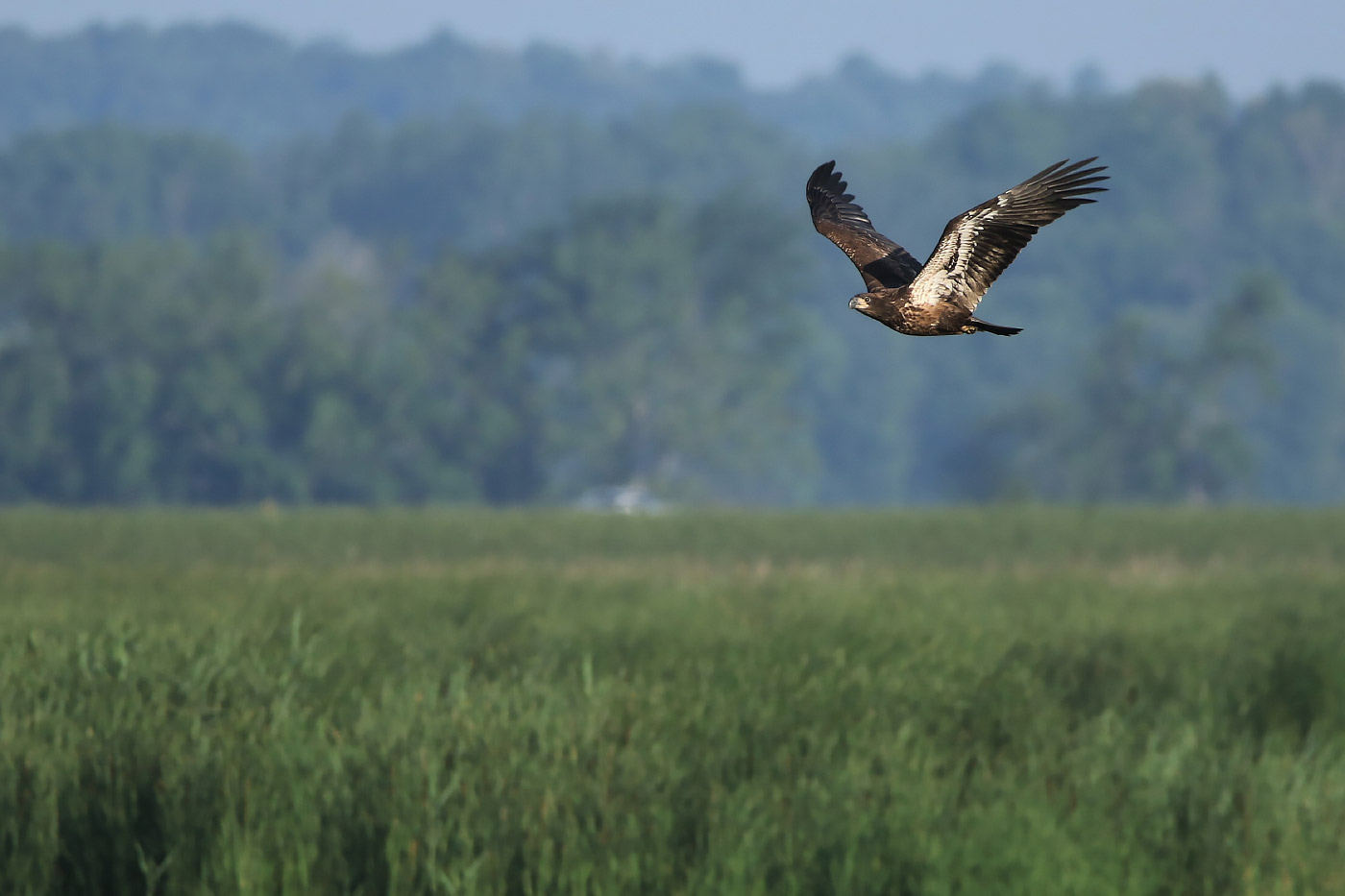
A young Bald Eagle flies across the open marshes at Montezuma National Wildlife Refuge (Alex Chapman).
The event was co-ordinated by a core group of three people, but almost everyone at Cornell was involved in some way. Those three people are Jessie Barry, who is Programme Manager, Chris Wood, Assistant Director of Information Science and a developer of eBird, and Ian Davis, an incredible birder and eBird Project Co-ordinator.
The trip got off to a bumpy start – my luggage hadn't arrived! Once it was set on the right path and greetings had been done with Jessie, we headed off to the hotel along with two other young birders, Estevão from Brazil, and Eliana from California – we all instantly hit it off and became very close friends.
The next day, 11 July, brought my first experience of birding in the States, alongside Chris Wood and Eliana. I decided to leave my photography equipment in the vehicle to focus on learning the local birds and having a more fulfilling experience. I regretted this almost immediately – sightings were close and abundant for a variety of species, almost all of which were lifers for me.
The fresh, humid air of the early morning at Myers Point, on the edge of Lake Cayuga, was serene, and everywhere I looked there was a lifer. These ranged from a Belted Kingfisher darting down a boggy channel to a Baltimore Oriole swiftly moving overhead. Northern Flickers showed beautifully along the roadside.
After Myers Point, we moved to another part of the area, briefly stopping for breakfast in an authentic bakery. We moved on to Summer Hill State Forest, where I had my first introduction to a bird-luring technique, known as playback. Avian highlights here included Yellow-bellied Sapsucker and the beautiful Blackburnian and Chestnut-sided Warblers. This was the first time the density of birds in the region really hit me, as within seconds of the tape running, a rotation of many individuals of at least 12 species appeared.
We next stopped in a place called Groton. Here a few Chimney Swifts and many Turkey Vultures were seen above the forested ravine. Being my first wild vultures, I was ecstatic!
On reflection, thoughh, leaving my camera behind was a great thing as I could experience American birding properly and just enjoy learning and being where I was without worrying about photography. It was superb.
Soon after this we arrived at the Cornell Lab of Ornithology. We slipped in one of the back doors and Chris kindly showed us to the office of 14-year-old Estevão. He gave us a unique insight into the daily processes of the lab – and allowed us to meet some incredible people we would otherwise not have met. One lady in particular had just finished co-ordinating the production of a documentary highlighting the importance of Africa's dwindling vultures – it was most interesting.
We then went birding in Sapsucker Woods, around the lab, where I got my first looks at Pileated Woodpecker, as well as brilliant views of a Red-tailed Hawk, which was being mobbed by about a dozen other birds while it sat in a tree.
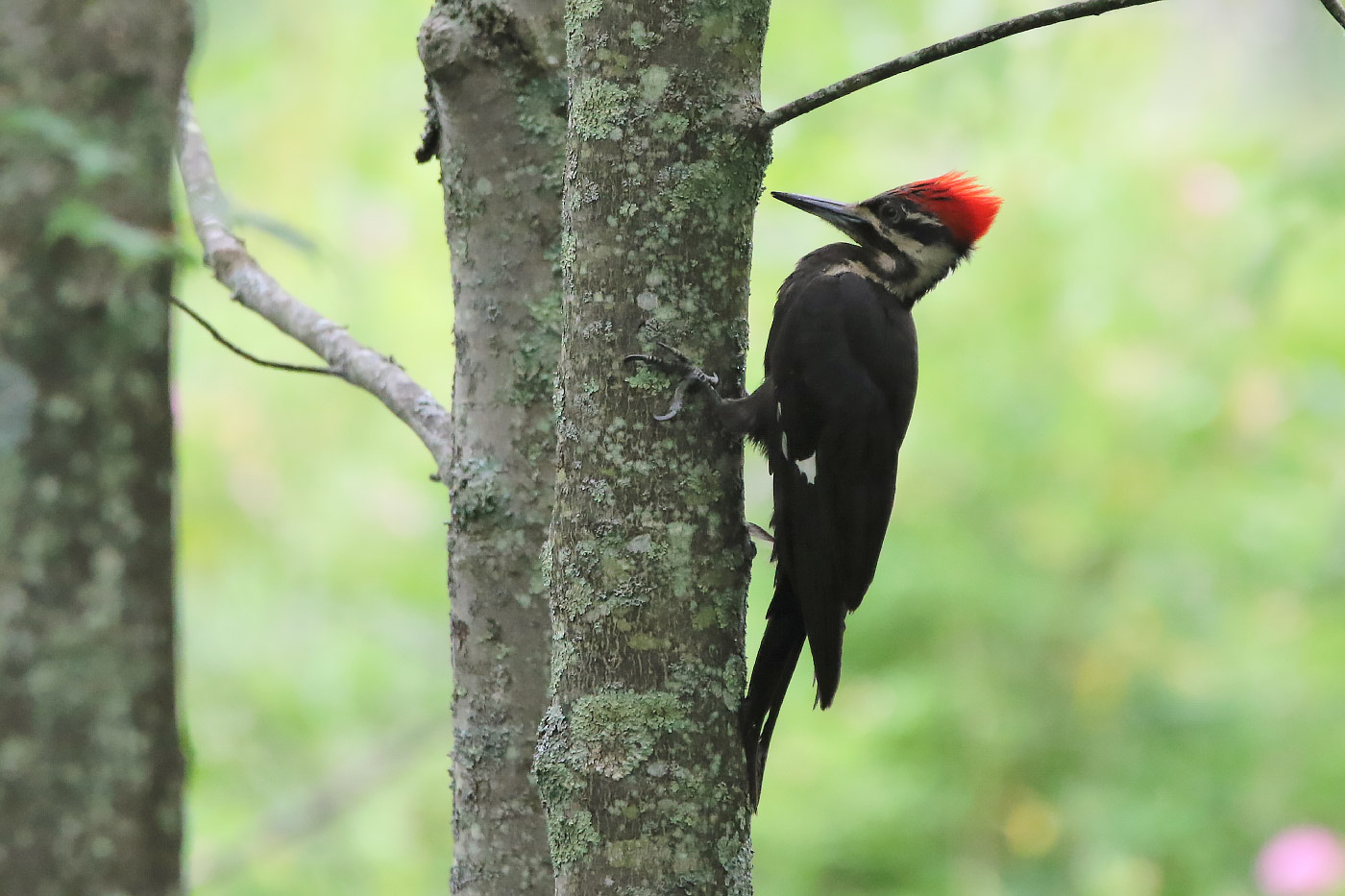
Pileated Woodpecker is widespread in North America, but is nonetheless a spectacular bird (Alex Chapman).
Shortly after this, the Cornell Young Birders Event officially began, and the other participants all arrived to collect a bag of goodies. So many great items were handed out, including books and T-shirts. A special gift from the event sponsors, Zeiss, was a high-quality, special-edition binocular – a gesture fully appreciated by all. A brief introduction and a series of talks followed, which certainly helped introduce me to the idea of birding in the US and the structure of pursuing ornithological interests as a career.
The following morning commenced at 5 am. After jumping on a minibus, half of us headed to Shindagin Hollow State Forest, while the others went elsewhere. We started the day sound recording, something I have never done before. It was thoroughly enjoyable once I had got to grips with how to use the equipment, along with finding the confidence to say what species I was recording!
I was sound recording alongside Estevão. He is one of the most unbelievably talented young guys I have ever met, and to be so influential in Brazil at his age is quite something – he is even an expert on North American birds, having just spent six weeks there! Estevão explained how he recognised the different calls and showed a really professional way of recording – along with help from Jessie, who stayed behind to give us tips now and then. Sound-recording highlights included great performances by a male Scarlet Tanager and a Black-throated Green Warbler. There was also a short but brilliant visit from a Sharp-Shinned Hawk.
The forest was stunning; so varied, with huge steep slopes down towards the river in the gorge and, as the sun climbed higher into the sky and lit the forest, we moved onto our next destination for the morning, Roy H Park Preserve, a short drive away.
There were chickadees left, right and centre, Chestnut-sided Warbler and a favourite of mine – a Magnolia Warbler, which posed beautifully. Two Barred Owls were also heard calling nearby, but we had no luck seeing them.
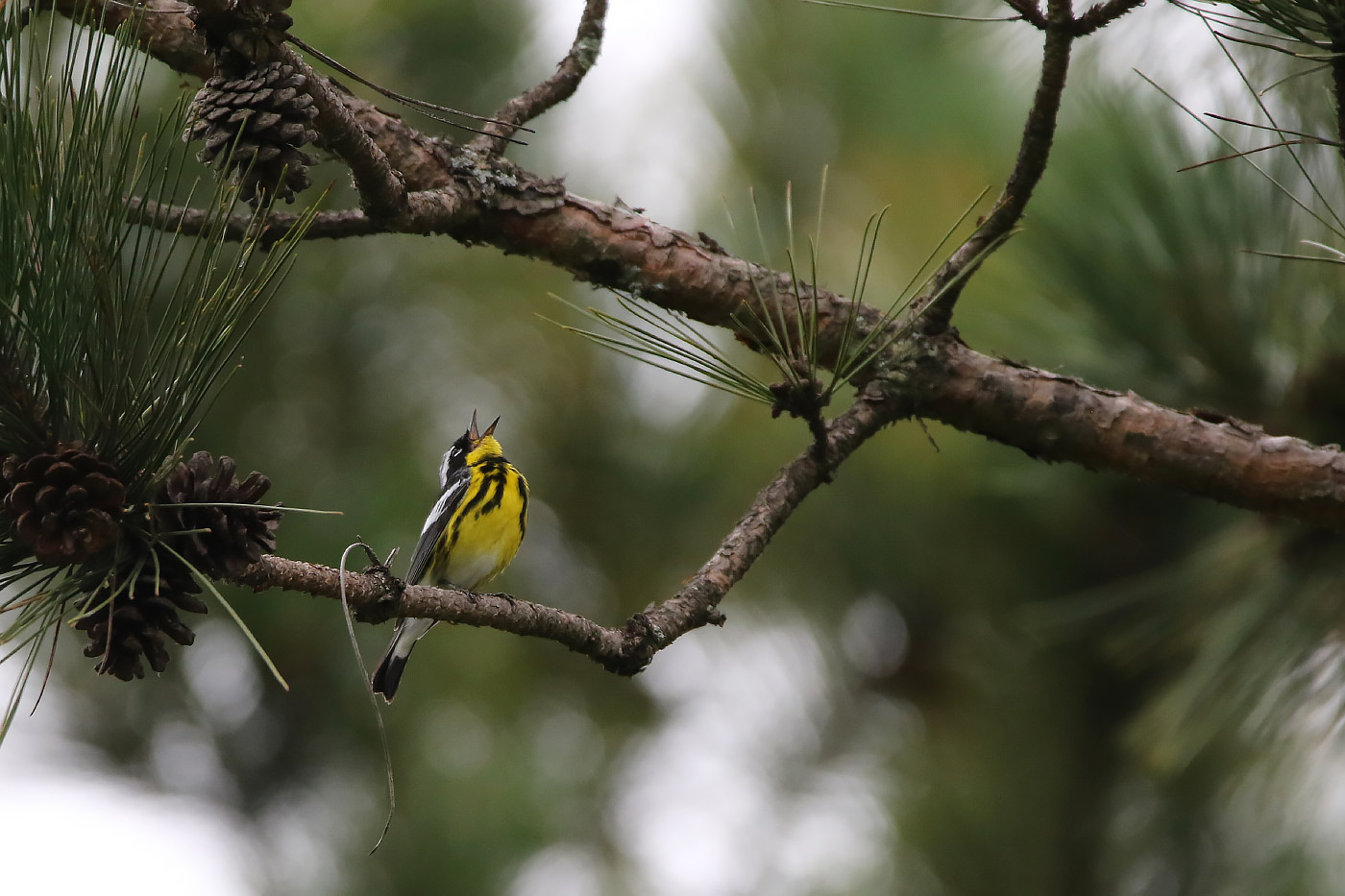
Male Magnolia Warbler in full song (Alex Chapman).
Lunch was followed by more instructive talks regarding our morning's sound recording, which had been neatly edited by Jay McGowan from the sounds department of the Macaulay Library.
We then had a tour of the Specimen Archives at the lab. Everyone thoroughly enjoyed this tour, and it began with an introduction as to how the study skins are prepared and sourced. There was a new delivery of specimens from the Middle East that had just been prepared, laid out so we could appreciate the process.
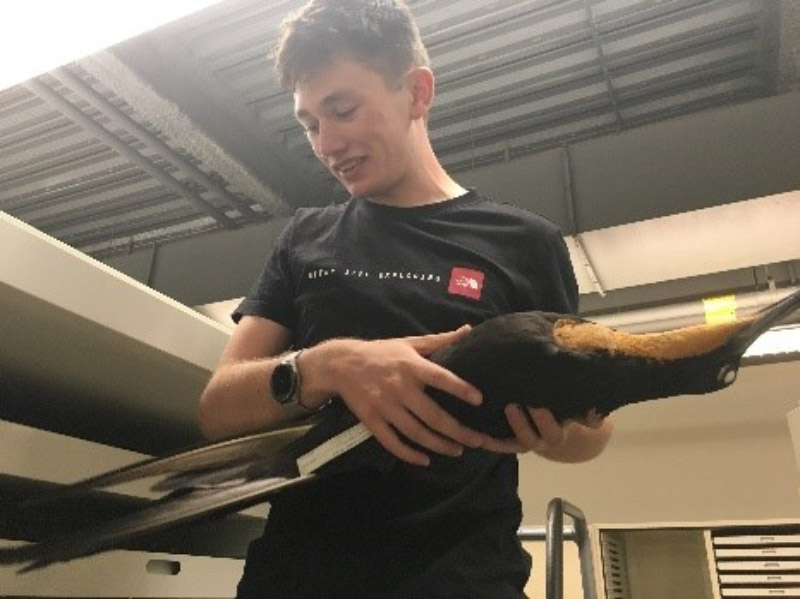
Alex with a male Magnificent Frigatebird at the Cornell Specimen Archive.
After this we headed into the archive – what an amazing collection! We were shown the extinct and Critically Endangered cabinet – with Passenger Pigeon, Ivory-billed Woodpecker, various Darwin's finches and a Harpy Eagle being the ones I was most enthused about. In just a couple of hours I looked at many species, including the Coraciiformes, which included the likes of kingfishers, bee-eaters and Hoopoe – these were of particular interest to me due to their highly adapted bills and wide variety of colour pigments. Other highlights included cassowary, Magnificent Frigatebird and the startling array of hummingbirds.
We were up early again on Saturday morning, jumping aboard the minibus to Montezuma National Wildlife Refuge. On arrival at the visitor centre, we were greeted by a great collection of Purple Martins, along with a few distant Bald Eagles and two American Bitterns. Further highlights around Montezuma's Wildlife Drive included more Bald Eagles, Caspian Tern, Eastern Kingbird and a family of Sandhill Cranes, including a just-visible chick. The day had started nicely!
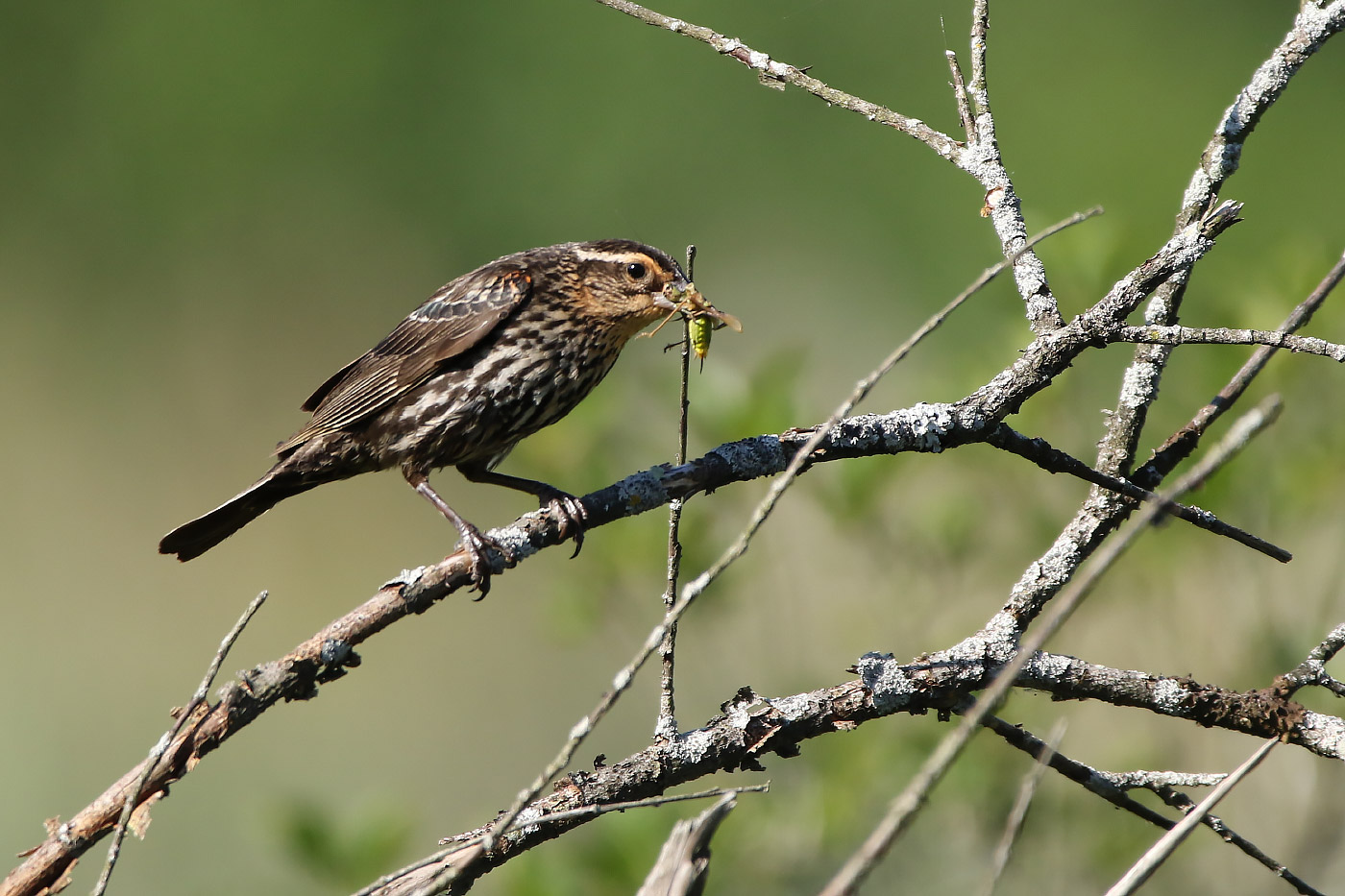
Female Red-winged Blackbird with snack (Alex Chapman).
We then moved on and tried for Cerulean Warbler. We saw about four individuals of this lifer for some of the young American birders as well as myself. In another Montezuma location, we added more species to our trip list, including Snow Goose, Double-crested Cormorant and (not a bird!) the iconic Monarch butterfly.
Soon after this we headed for lunch in a nice restaurant overlooking the middle of Lake Cayuga. While many more ospreys were sighted in this single location, my species total hit 44 – which is a little less than what Elliot managed last year.
After a failed attempt to find Upland Sandpiper, we headed back towards the lab to learn about 'R'. This is a programming language and free software environment for statistical computing and graphics which helps to map out species distributions and lots of other data in the lab. We were given a quick crash course on 'R', and it would appear is if it is very prominent in the work of the lab. A few of us also stayed behind to have a bit more of an in-depth insight into the workings of 'R' – this is certainly a tool worth using in the world of data analysis.
After our last supper together, we all reassembled in the main lecture room for one of our final presentations. It was co-presented by Andy Johnson, a photographer and filmmaker associated with the labs who has been to most corners of the earth. The talk was about conservation media, and it was inspiring and empowering, and showed the lengths that commissioned and non-commissioned photographers and filmmakers go to, to document and study rare and endangered species in some of the harshest areas on the planet. He talked most specifically about St Matthew Island and McKay's Bunting in the Bering Sea of the North Pacific.
Sunday 14 July was our morning of birding together as the Cornell Young Birders 2019. We went to the Lindsay-Parsons Biodiversity Preserve, where new habitats brought us a beautiful Black-billed Cuckoo and, weirdly, a Porcupine sat at the top of a tree – now that was quite something! There was also a Great Egret or two about and we managed good views of Indigo Bunting and Scarlet Tanager.
After this exciting affair we headed off elsewhere. Sightings included yet more lifers for me – Virginia Rail, Sora and Broad-winged Hawk among them.
At our penultimate location, we encountered a female Ruby-throated Hummingbird on a nest about the size of a two-pence piece. To see such a small bird with such a high metabolism sitting on a nest was quite exciting, and gave a whole different perspective for me on them. We were all thrilled with the sighting.
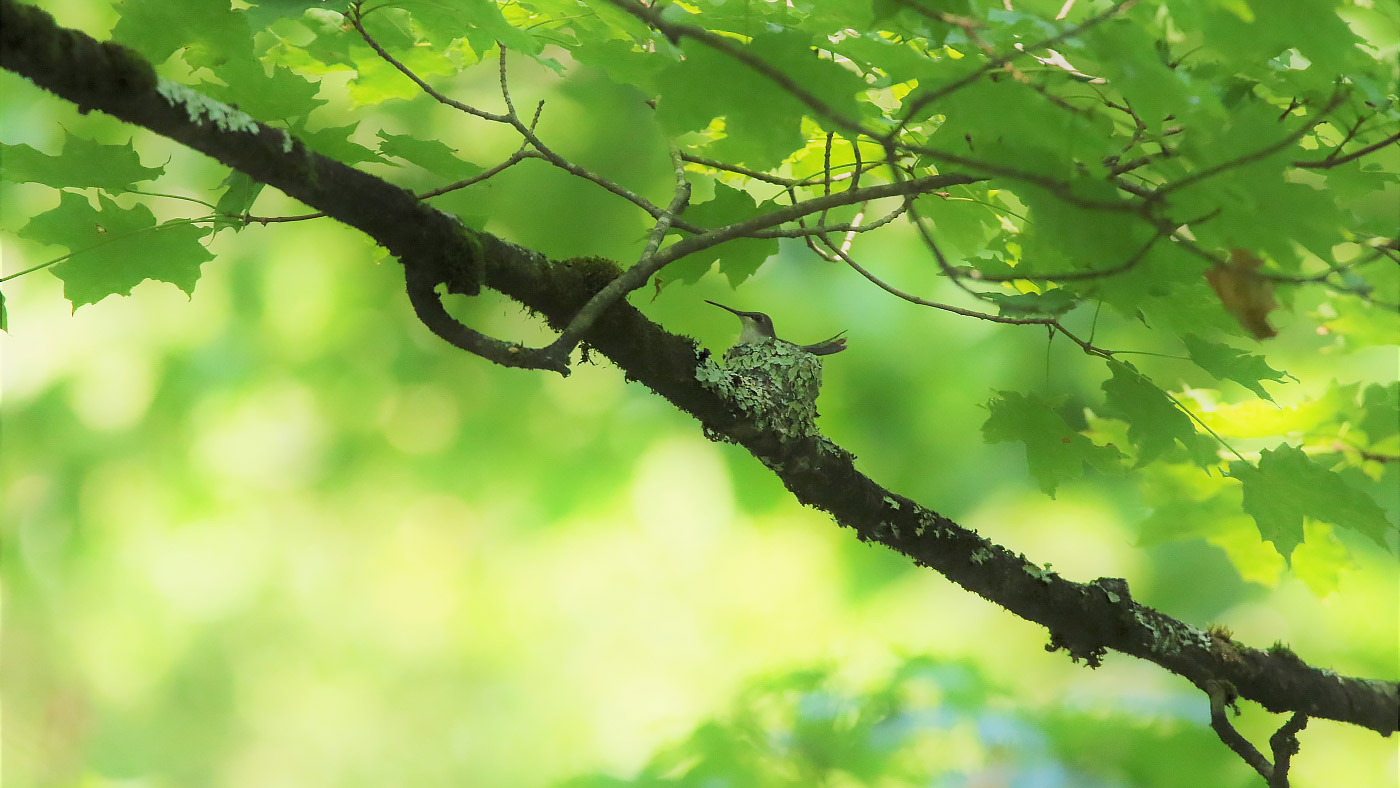
A female Ruby-throated Hummingbird sat tightly on her nest was one of the highlights of the week (Alex Chapman).
It was then back to the lab, where there was a final talk and a chance to thank everyone and say goodbye. I still had most of the day until my flight left, however, so I joined a campus tour on which Chris, Jessie, and myself did some bird counts at the back – the campus is beautiful and the architecture is sublime. Ithaca is also a great place.
As my flight took off in the golden and crisp evening from Ithaca Airport, I felt a huge sense of fulfilment take over. After a tough year, I felt like I had never felt before: happy, proud, excited and fulfilled are the main words to describe it. I opened the pages of Wilding by Isabella Tree and continued reading while listening to Billy Joel's New York State of Mind. My life had been changed forever!
Since I have been home, I have really set to work at making a difference. My first point of action was to buy a new birding desk – success. I have since been out birding, meeting new people, volunteering, getting involved with projects and planning new trips, endlessly – at some point I will have to think about my A-Levels again, but that will come in time! For now, I live for nature, and that's how I want to live my life – I can't wait to continue to work and hopefully have a positive impact on birding for all.
Birding isn't just about competition for the longest life lists and the best photos, it is also about sharing what is available to all of us with those people who don't always see or appreciate it. We need to welcome new birders with open arms and give more people, young and old, the opportunity to become a serious birder. In the US, a third of people will go specifically birding at some point in their life – here, that figure is a fraction of that. That can be changed through positivity and a rethink of the way we advertise bird and wildlife watching as a hobby. However, birding is becoming more popular and accepted here. Times are changing, and positivity towards birding and within the birding community is getting there. More of us welcome the young, the old, the LGBTQ, all races and genders.
I would like to thank everyone involved in the process of my inspiring trip to Cornell. Thank you to Chris, Jessie and Ian for being the best mentors, everyone at Cornell for the inspiring talks and meetings, Elliot for your support throughout, Keith for your continued support, and what could be considered most importantly, Corinne and everyone at the Cameron Bespolka Trust giving me the opportunity to have a platform in which to hopefully spread my wings in the ornithological world.
The Cameron Bespolka Cornell Bird Event scholarship will run again in 2020. If you are a birder aged 16-18 and would like to apply, please visit the Cameron Bespolka Trust website: www.cameronbespolka.com/sponsorship-to-attend-cornell-university-ornithology-event.

